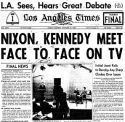 This has been a very busy busy month, but I’ve had a few minutes to note some headlines about the highways…
This has been a very busy busy month, but I’ve had a few minutes to note some headlines about the highways…
- Motorists on the 118 Freeway notice this smile marker. Steve Apostolof had a frown on his face as he drove past Happy Face Hill. The hillside features a 150-foot-wide smiley face that was created in 1998 by a man armed with a weed-whacker and a sprayer of herbicide. Since then, it has become something of a curiosity piece that welcomes motorists on the 118 Freeway to Simi Valley. But in the January dusk, Apostolof couldn’t see Happy Face Hill, let alone its enormous grin.
- Highway 101 widening project jumps financial hurdle. The Sonoma County Transportation Authority on Monday approved $4.5 million to buy land to widen Highway 101 to six lanes through Petaluma, but it will be at least three years, and perhaps longer, before there is a remedy to the bottleneck that has plagued commuters for years.
- Devils Slide Trail almost ready for unveiling. The views on Highway 1 at Devils Slide were spectacular, but to admire them while driving was to blow a kiss at death. From the time the twisting coastal artery opened in 1937 until its closure last year, cars plunged with disturbing frequency into the surf several hundred feet below. So the opportunity to savor the vista is a welcome change, said Jon Zilber, one of two dozen volunteers who have gotten a sneak peek at the abandoned roadway’s reincarnation: the Devils Slide Trail.
- How to Pull California Traffic Count Data for State Highways. I was working on a custom data request for a new business owner who was considering a particular location for a new venture. This owner wanted California traffic count data for the highway near the potential location. Here’s how I got traffic count data for this California state highway.
- CityDig: Before the 405 Was Paved. Today a river of concrete passes through Sepulveda Canyon, one of the three main portals between the San Fernando Valley and the Los Angeles Basin. But in 1934 that mighty river—the 405 freeway—was only a modest stream, a winding, unpaved road that snaked through the Santa Monica Mountains.
- First toll lanes in Contra Costa to be installed along I-680 in San Ramon Valley. The long slog for commuters traveling from Walnut Creek to San Ramon could get shorter — for a price. The first toll lanes in Contra Costa County are expected to open there on Interstate 680 by mid-2016, said John Goodwin, a Metropolitan Transportation Commission spokesman. The $45 million project, which is in the design stage, will create 23 miles of FasTrak express lanes that will allow solo drivers to pay to use carpool lanes — as long as its traffic is moving at least 45 mph. Construction is expected to begin at the start of 2015.
- They Moved Mountains (And People) To Build L.A.’s Freeways. …it’s possible that all the dire warnings and clever pranks obscured a more troubling possibility: that Carmageddon had already come to pass decades ago, in the 1940s, ’50s, and ’60s, when Los Angeles scarred its landscapes, split its communities, and displaced a quarter-million people to build its 527-mile freeway system.
- Construction Underway on I-5 in South Orange County. Drivers have started to see construction activity ramping up on the San Diego Freeway (I-5) in South Orange County as crews began work on a $249-million traffic-relief project last week. The I-5 South County Improvement Project will add a carpool lane in both directions between San Juan Capistrano and San Clemente as well as rebuild the Avenida Pico interchange in San Clemente.
- Northwest 138 Corridor. The Northwest 138 Corridor project will expand on the previous North County combined Highway Corridor Study which was completed in 2004 to develop a multi-modal transportation plan for the northern portion of Los Angeles County to address both short and long-term needs for a variety of trip purposes and goods movement. To accommodate the potential for both population and economic growth in the future, recommendations were made to improve this portion of SR-138.
- Devil’s Slide, once hellish, opens Thursday as heavenly trail. Until its retirement about a year ago, the treacherous stretch of Highway 1 known as Devil’s Slide was a white-knuckle ride, a dizzying drive where motorists nervously kept their eyes on the road, resisting the temptation to glance at the Pacific Ocean hundreds of feet below. But since the twin-bore Devil’s Slide Tunnel opened last March, the old bluff-top highway has been transformed into a place to relax, slow down and enjoy the spectacular view. On Thursday, the Devil’s Slide Trail, a 1.3-mile path for hikers, cyclists and horseback riders, opens to the public.
- Autry’s ‘Route 66’ exhibition looks for its funding kicks online. The Autry National Center of the American West is hoping lots of people will get their kicks by giving money online to help fund its coming exhibition “Route 66: The Road and the Romance.” The Autry, which will open the show June 8, joins the likes of the Louvre and the Smithsonian Institution’s Asian art museums in using a “crowdfunding” site to lasso donations. The Autry can appeal to people who otherwise might not know of the L.A. museum’s existence but are fans of Route 66 and its manifestations in pop culture.
- Caltrans to pay $12.7 million extra to put Bay Bridge demolition back on schedule. Caltrans says it will put the $300 million demolition of the old Bay Bridge east span back on schedule by paying $12.7 million for extra labor and equipment. The three- to five-year-long demolition project fell several months behind schedule out the starting gate when Caltrans reallocated labor and resources to open the $6.4 billion new east span as soon as possible. It opened Sept. 2 after years of delays and cost overruns.
- Roundabout is latest in downtown Roseville makeover. Within a matter of weeks, work should get started on the city of Roseville’s next phase of overall downtown improvement, though this one may take drivers some getting used to. By the end of the year, a two-lane roundabout is planned to be in place where Washington Boulevard meets Oak Street, a $3.02 million construction project. (h/t Joel W.)
- Caltrans Seeking Solution for Water-Logged Castillo Street Underpass. An estimated 20,000 vehicles a day pass through the Castillo Street interchange under and near Highway 101, an area that is consistently plagued by standing water and pavement problems. Now, the agency that owns the interchange is working on a solution, albeit a temporary one, that it hopes will help solve the road’s issues. The underpass was built in 1960, but damage from an earthquake in the area in 1971 created large cracks in the slabs of concrete that make up the roadway, said David Beard, project manager for Caltrans, which owns that section of road.
- Risky Berkeley intersection to be fixed in roundabout way. The intersection at the west end of Gilman Street in Berkeley is daunting to even the most confident of drivers. Eight lanes of traffic lead onto and off of busy Interstate 80; four different frontage roads converge on the interchange; Gilman Street runs right through the middle of it all; and the Bay Trail, which runs just west of the intersection, leaves bicyclists and pedestrians to navigate the dangerous roadway, which is often populated with frustrated drivers and is only governed by a handful of stop signs.


 Yesterday, I asked people
Yesterday, I asked people  Well, it’s Saturday, and you know what that means — a tasty news chum stew of the leftovers that couldn’t make a coherent dish during the week:
Well, it’s Saturday, and you know what that means — a tasty news chum stew of the leftovers that couldn’t make a coherent dish during the week: This has been a busy week between work, headaches, our daughter being home, and planning for a new phone (acquired yesterday). Still, a few articles caught my eye, and some of them even themed. In particular, this set of items, all dealing with things we’ve seen in the past:
This has been a busy week between work, headaches, our daughter being home, and planning for a new phone (acquired yesterday). Still, a few articles caught my eye, and some of them even themed. In particular, this set of items, all dealing with things we’ve seen in the past:
 Yesterday, my RSS feeds highlighted a provocative article: “
Yesterday, my RSS feeds highlighted a provocative article: “
 This has been a weekend of Jewish-themed plays. Last night we learned
This has been a weekend of Jewish-themed plays. Last night we learned 
 Oh, sorry, wrong Nazi musical. Perhaps I should start over…
Oh, sorry, wrong Nazi musical. Perhaps I should start over…